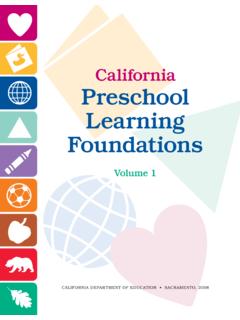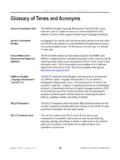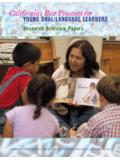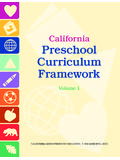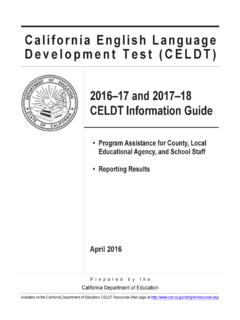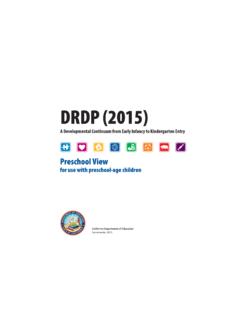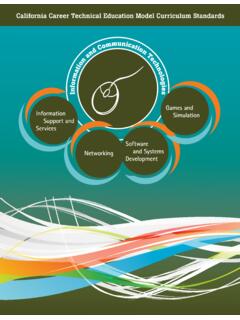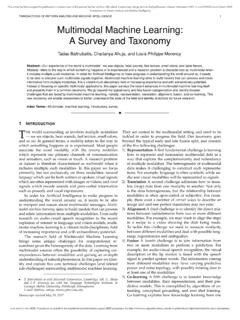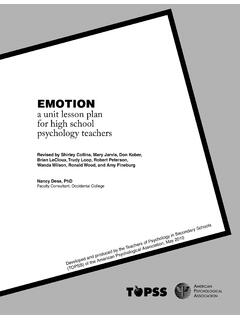Transcription of California Infant/Toddler Learning & Development …
1 California Infant/Toddler Learning & Development Foundations California DEPARTMENT OF EDUCATION SACRAMENTO, 2009. California Infant/Toddler Learning & Development Foundations California Department of Education Sacramento, 2009. Publishing Information The California Infant/Toddler Learning and Development Founda . tions was developed by the Child Development Division, California Department of Education. It was edited by Faye Ong, working in cooperation with Tom Cole, Consultant, Quality Improvement Office. It was prepared for printing by the staff of CDE Press: the cover and interior design were created and prepared by Juan D. Sanchez; typesetting was done by Jeannette Reyes. It was published by the Department, 1430 N Street, Sacramento, CA. 95814-5901. It was distributed under the provisions of the Library Distribution Act and Government Code Section 11096. 2009 by the California Department of Education All rights reserved ISBN 978-0-8011-1693-3. Notice The guidance in the California Infant/Toddler Learning and Development Foundations is not binding on local educational agencies or other entities.
2 Except for the statutes, regulations, and court decisions that are referenced herein, the document is exemplary, and compliance with it is not mandatory. (See Educa . tion Code Section ). Contents A Message from the State Superintendent of Public Instruction v Acknowledgments vii Introduction ix The Early Months 1. Social-Emotional Development 7. Language Development 43. Cognitive Development 59. Perceptual and Motor Development 89. Appendix: Summary of Infant/Toddler Foundations 103. iii A Message from the State Superintendent of Public Instruction I. am delighted to present the care, which is critically important for California Infant/Toddler Learning children's social-emotional well-being and Development Foundations, a and overall Learning . With a goal of publication I believe will contribute to ensuring that all Infant/Toddler pro . providing high-quality care and educa grams in California offer high-quality tion for our youngest children. care, the California Department of The first three years are a crucial Education collaborated with lead.
3 Time of Development . Research on ing early childhood educators and brain Development indicates that the researchers to develop these Learning brains of infants and toddlers are and Development foundations. twice as active as those of adults. By The foundations focus on four the time children reach the age of domains: social-emotional develop . three, they have become competent in ment, language Development , cognitive at least one language, formed a sense Development , and perceptual and of self, learned about basic concepts motor Development . The foundations such as cause-and-effect and quantity, provide a comprehensive understand . and developed numerous large- and ing of young children's Learning and small-muscle skills. Development during the first three More than half of California 's years of life. infants and toddlers are cared for in It is my hope that these foundations child care centers, in family child care will help all California Infant/Toddler homes, and by relatives or neighbors programs to offer developmentally outside the home.
4 Research shows that appropriate and supportive care for good care and education contribute to our youngest children. By fostering the children's social-emotional, language, Learning and Development described cognitive, and perceptual and motor in this publication, Infant/Toddler Development . High-quality infant /tod care professionals will contribute to dler programs provide children with children's well-being and lay the foun . caring relationships, environments, dation for children's future success. and materials that enrich Learning and Development . Those programs also develop partnerships with families to connect children's home experiences JACK O'CONNELL. with experiences in the Infant/Toddler State Superintendent of Public Instruction setting. Partnerships with families are the cornerstone of culturally sensitive . Acknowledgments T. he following people contributed Katie Monahan, Program Assistant to this publication or helped to Teresa Ragsdale, Program Assistant develop the ideas: University of California , Berkeley Panel of Experts Berkeley Evaluation and Marc Bornstein, National Institute of Assessment Research Center Child Health and Human Development Stephen Moore, Center Associate Linda Brault, Sonoma State University Director Deborrah Bremond, Alameda County Mark Wilson, Center Director.
5 Children and Families Commission Professor, UC Berkeley Vera Guttierez-Clellan, San Diego State University California Department Christopher Lonigan, Florida State of Education University Tammy Mann, Zero to Three Meredith Cathcart, Consultant, Lucia Palacios, Los Angeles Universal Special Education Division Preschool Tom Cole, Consultant, Jeree Pawl, Clinical Psychologist Child Development Division Todd Risley, University of Alaska Cecelia Fisher-Dahms, Administrator, Ross Thompson, University of Califor Quality Improvement Office nia, Davis Michael Jett, Former Director, Marlene Zepeda, California State Child Development Division University, Los Angeles Camille Maben, Director, Child Development Division Anthony Monreal, Deputy Super . WestEd, Center for Child intendent, Curriculum and and Family Studies Instruction Branch Content Development : Mary Smithberger, Consultant, Ron Lally, Program Codirector Child Development Division Peter Mangione, Program Codirector Gwen Stephens, Former Assistant Charlotte Tilson, Senior Program Director, Child Development Associate Division Cathy Tsao, Senior Program Associate Maria Trejo, Administrator, Sara Webb-Schmitz, Program Associate Child Development Division Osnat Zur, Senior Program Associate Research assistance: Note: The names and affiliations of individuals were Amy Schustz-Alvarez, Program current at the time of the Development of this publi.
6 Assistant cation. ii Introduction T. he California Infant/Toddler children's experiences at home with Learning and Development their experiences in the infant /tod . Foundations represents part of dler program. These partnerships with the Califor nia Department of Educa families are the cornerstone of cultur . tion's (CDE's) comprehensive effort to ally sensitive care. Connections with strengthen young children's Learning children's early cultural and linguistic and Development through high-quality experiences are critically important early care and education. The founda for their social-emotional well-being, tions describe competencies infants the Development of their identity, and and toddlers typically attain during the Learning . In addition, children may birth-to-three-year period. In order to have a special need that requires par . make developmental progress, young ticular accommodations and adapta . children need appropriate nurturing. tions. To serve all children, infant /tod.
7 Both supportive home environments dler programs must work to provide and high-quality early care and educa appropriate conditions for each child tion programs can facilitate children's and individually assist each child's attainment of the competencies speci movement along a pathway of healthy fied in the foundations by providing Learning and Development . safe environments and an emotionally Over 20 states have either developed secure base for active, playful explora Infant/Toddler standards documents or tion and experimentation. are in the process of doing so. Many of During the Infant/Toddler years, all them have sought to align infant /tod . children depend on responsive, secure dler standards with preschool Learning relationships to develop and learn. standards. Because both infant /tod . As stated in the CDE's Infant/Toddler dler and preschool foundations in Cali . Learning and Development Program fornia cover a broad range of learn . Guidelines (2007), high-quality pro ing and Development domains, the grams offer infants and toddlers pri term foundations is used rather than mary relationships in small groups.
8 Standards. This term was selected to Such programs provide personalized convey that Learning across all devel . care that reflects consideration for opmental domains builds young chil . individual differences among children. dren's readiness for school. In essence, Programs also develop partnerships the foundations pertain to young chil . with children's families to connect dren's current and long-term develop . ix x mental progress. This focus is conso The foundations developed for nant with the position of the National each of these domains are based on Association for the Education of Young research and evidence from practice. Children (NAEYC) and the National Suggestions of expert practitioners and Association of Early Childhood Special examples illustrate the foundations. ists in State Departments of Education The purpose is to promote understand . (NAECS/SDE) on early Learning stan ing of early Learning and Development dards. As the position statement sets and guide efforts to support the devel.
9 Forth, Early childhood is a distinct opment and well-being of infants and period of life that has value in itself toddlers. as well as creating the foundations for later years (NAEYC and NAECS/SDE Overview of the Foundations position statement 2002, 3). The foundations for each of the four In California , priority has been domains are listed in this section. placed on aligning the Infant/Toddler Learning and Development foundations Social-Emotional Development with the preschool Learning founda Domain. The social-emotional devel . tions in four major domains: opment domain covers the following foundations: Social-emotional Development Interactions with Adults: The Language Development child's developing ability to Cognitive Development respond to social cues from Perceptual and motor develop adults and engage in back-and . ment forth social exchanges with adults The domains represent crucial areas of early Learning and Development that Relationships with Adults: The contribute to young children's readi child's Development of close rela.
10 Ness for school (National Research tionships with adults who provide Council and Institute of Medicine consistent nurturance 2000; NAEYC and NAESC/SDE 2002). Interactions with Peers: The The foundations present key concepts child's developing ability to in each domain and provide an over respond to social overtures from view of Development in that domain. peers, engage in back-and-forth Young children can be considered from interaction with other children, the perspective of one domain, such as and, ultimately, to engage in social-emotional Development or lan cooperative play with other chil . guage Development . Yet, when taking dren. an in-depth look at a single domain, Relationships with Peers: The one needs to keep in mind that learn child's Development of relation . ing, for young children, is usually an ships with certain peers through integrated experience. For example, an interactions over time infant may make a cognitive discovery about cause-and-effect while making Identity of Self in Relation to Oth.

